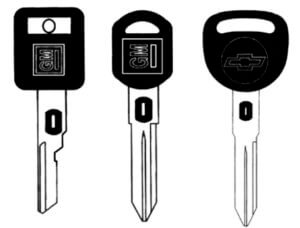GM VATS Anti-theft System
Learn about the GM VATS, PassKey I and PassKey II Anti-theft System in Detail
The GM Vehicle Anti Theft System (VATS) was first introduced on the 1986 Chevrolet Corvette. GM was feeling pressure to come up with an anti-theft system for this vehicle because it had become the #1 target of car thieves. Once introduced, thefts of VATS equipped cars dropped significantly. So in 1998 GM brought the system into use on the Camero, Pontiac, Buick and Oldsmobile brands.
VATS becomes PassKey
GM changed the name of the anti-theft system from VATS to PassKey I and PassKey II, indicating that the mechanism relied on the KEY for identification. This is an important distinction because the next generation PassLock did not rely on the key itself (which turned out to be a big mistake).
The VATS and PassKey
VATS and PassKey I and PassKey II systems rely on an embedded resistor chip (pellet) located in the shank of the key between the machined grooves and the head of the key. Electrical contacts located in the lock cylinder contacted the resistor pellet and the system measured voltage drop induced by the pellet. The system looks for a pre-set voltage drop that was programmed into the unit at the factory.
How VATS and PassKey I and PassKey II prevents theft
If the system detects a current drop that is higher or lower than the expected value, the anti-theft control will send a no-start signal to the PCM and the PCM will prevent engine start for several minutes. An indicator on the dash will light, telling the driver that the engine has been disabled.
The several minute time delay is a significant feature of the VATS, PassKey I and PassKey II systems. The whole point of the delay is to frustrate car thieves if they try to insert the wrong key. They simply can’t afford to wait out the delay period. VATS, PassKey I and PassKey II vehicles became the least stolen vehicles.
The last VATS equipped vehicles were the 2003 Camero and Firebird.
The VATS, PassKey I and PassKey II Keys
The first generation keys were designed with 15 different resistor  pellets, numbered 1 through 15. The #1 key had the lowest resistance and #15 had the highest resistance. However, in practice, the low resistance of the #1 key caused read errors in the field. GM discontinued the #1 key for the 1989 model year.
pellets, numbered 1 through 15. The #1 key had the lowest resistance and #15 had the highest resistance. However, in practice, the low resistance of the #1 key caused read errors in the field. GM discontinued the #1 key for the 1989 model year.
Measuring the value of the VATS, Passkey I and PassKey II keys
Use an ordinary DVOM to measure the resistance value of the key. Then refer to the chart to convert the resistance (Ohms) to the proper key. The resistance may not match exactly because there is a built in tolerance of ±3%. Refer to the chart below to match the resistance to the key number.
VATS Pellet Number Resistance Value Letter Codes
VATS #1 0.402K None
VATS #2 0.523K CN or YT
VATS #3 0.681K FW or JB
VATS #4 0.887K EJ or GP
VATS #5 1.130K KA or KP or UR
VATS #6 1.470K N5 or Q3
VATS #7 1.870K KH or UN
VATS #8 2.370K XB or ZB
VATS #9 3.010K GA or QM
VATS #10 3.740K NP or XJ
VATS #11 4.750K FY or JH
VATS #12 6.040K C5 or CR
VATS #13 7.500K KM or XY
VATS #14 9.530K ET or KB
VATS #15 11.800K U3 or UW
Duplicating a VATS, PassKey I or Passkey II key
If you’re just adding a key to the system, simply measure the resistance value of the key, match it to the right blank and cut the key. Or, if the two digit key code is stamped into the original key, just match it to a new key and you won’t have to measure anything.
However, if you’ve lost the key you need to find out two things; what key resistance value has been programmed into the theft deterrent module so you can match the new key to it and the key cutting sequence to match the lock cylinder. To get the key cutting code, contact the dealer parts department and provide your title and ID. Or, purchase a new lock cylinder
Then you’ll have to find the key resistance stored in the system. There are only two ways to do this.
Have all fifteen keys cut to the lock cylinder and try each one. You will have to wait out the delay period for each key try.
Connect an interrogator. 
If you’ve lost the original key, your best bet is to contact an automotive locksmith and have them interrogate the system. Or, you can buy an interrogator from Lockmasters.com
What the VATS, PassKey I and PassKey II Security Light means
GM used several variation of the anti-theft notification light. Some say SECURITY, ANTI-THEFT or just THEFT.
If the light doesn’t come on, the system is not working
If the light comes on and stays on during the entire time the ignition is in the RUN position, the system is working and the key pellet was read but it is the wrong value. Turn the IGN off and wait 3 mins before trying a different key value.
If the light comes on briefly and TURNS OFF, the system is working and the key pellet was read and is the CORRECT value. If the engine doesn’t start, it’s NOT caused by the anti-theft system.
If the light BLINKS, it may mean a door is open. However, if all the doors are closed and the light BLINKS, the system is not working.
If the light comes on and stays on even after the IGN has been turned OFF, the system is in time out mode. Wait until the light turns off and try a different key
©, 2018 Rick Muscoplat
Posted on by Rick Muscoplat